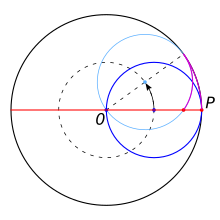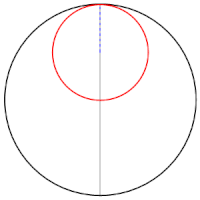Cardan circles
In the Euclidean plane, cardanic circles are the special cases of hypocycloids in which the small (rolling) circle is half the size of the large (solid) circle. (The small circle rolls inside the large circle.) What is special about this special hypocycloid is: Each point of the circular arc of the small circle moves on a diameter of the large circle.
history
The Nebra Sky Disc contains a mechanism similar to the gimbal circles (the Nebra Sky Disc has ellipses instead of circles).
In English literature this special hypocycloid is called Tusi couple (Tusi couple) after the 13th century Persian astronomer and mathematician Nasir ad-Din at-Tusi . Nasir ad-Din at-Tusi described the Cardan circles in his work "Tahrir al-Majisti" from 1247. The term "Tusi couple" was only coined in 1966 by Edward Kennedy .
The connection that each point of the arc of the smaller circle moves on a diameter of the larger circle was described in 1570 by the Italian humanist Gerolamo Cardano , to whom the German term "Cardanic circles" refers. These early studies of cycloids would later be expanded upon by Galileo .
The connection between the work of Nasir ad-Din at-Tusi and the European scholars is believed, but the connection has not yet been reliably reconstructed. It is striking that in the works of Copernicus the points were named phonetically similarly as in the works of Tusi.
Formulation and proof of Cardano's theorem
Given is a circle k (blue) with center M and radius r , which lies in a circle K (black) with center O and double the radius R = 2 r and touches this at point P (see picture).
Then:
- When the small circle rolls inside the large circle, the point fixed on the small circle moves on a diameter of the large circle.
Addition: Each point of the circular line of the small circle moves on a diameter of the large circle.
Proof:
To prove this, imagine the movement of the point broken down into two rotary movements: 1) rotation around the point by the angle and 2) rotation around the new center point of the small circle by the angle . If one uses complex numbers and their representation as a Gaussian number plane , then
- and
- .
The image of the point (real number!) Is then:
- .
The trajectory of the point is therefore the real interval (diameter of the large circle.)
Technical applications
If the outer circle is internally toothed and the inner circle is designed as a gear, then with the help of Cardanic circles, a rotational movement can be converted into a periodic linear movement.
Letterpress presses
This principle was the basis for the invention of the high-speed letterpress presses from König & Bauer .
Engines
James White received a medal from Napoleon Bonaparte in 1801 for a motor that used a hypocycloidal linear guide. A few engines were built according to White's design, but there was no commercial success.
Matthew Murray developed a hypocycloidal motor in 1802.
General
In technical applications, the mechanism is also known as hypocycloidal straight line guidance .
Franz Reuleaux's collection of gears contains two models of hypocycloidal linear guides.
literature
- Girolamo Cardano: Opus novum de proportionibus, Basel 1570. (Archimedes Project)
- Otto Lueger: Lexicon of the entire technology and its auxiliary sciences. Vol. 2 Stuttgart / Leipzig 1905, pp. 423-424
Web links
- https://www.tu-chemnitz.de/mb/MechAntrTech/getriebebibliothek/DB_index.php?TAB=Getriebemodell&NR=147 (model for the use of the Cardanic circles in gear technology)
Individual evidence
- ↑ http://sternwarte-recklinghausen.de/astronomie/himmelscheibe-von-nebra/
- ↑ http://sternwarte-recklinghausen.de/astronomie/himmelscheibe-von-nebra/
- ↑ http://www.columbia.edu/~gas1/project/visions/case1/sci.2.html
- ^ Gerolamo Cardano (1501–1576), Opus novum de proportionibus, 1570
- ↑ Nikolaus Kopernikus : How the reciprocal movement of the libration consists of circular movements. . In: De revolutionibus orbium coelestium , book 3, chapter 4 ( alternative link ).
- ↑ http://www.columbia.edu/~gas1/project/visions/case1/sci.2.html
- ↑ http://adsabs.harvard.edu/full/1973JHA.....4..128V
- ↑ http://www.mirrorservice.org/sites/gutenberg.org/2/7/1/0/27106/27106-h/27106-h.htm
- ↑ http://www.gutenberg.org/files/27106/27106-h/27106-h.htm
- ^ Robert Stuart: Historical and Descriptive Anecdotes of Steam Engines, and of Their Inventors and Improvers. Wightman and Cramp, 1829, p. 634 ( limited preview in Google Book search).
- ↑ http://www.pollymodelengineering.co.uk/sections/stationary-engines/anthony-mount-models/murrays-Hypocycloidal-Engine.asp
- ↑ http://dampfundmehr.de/im-bau/Hypocycloidal/hypo_7.htm
- ↑ http://de.academic.ru/dic.nsf/technik/9302/Geradf%C3%BChrung%2C_hypocykloidische
- ↑ http://www.zeno.org/Lueger-1904/A/Geradf%C3%BChrung,+hypocycloidische
- ↑ http://kmoddl.library.cornell.edu/model.php?m=137
- ↑ http://kmoddl.library.cornell.edu/model.php?m=278















![{\ displaystyle [-2r, 2r]}](https://wikimedia.org/api/rest_v1/media/math/render/svg/f9c7de55acfd7ae334fedbdb38fb4a5bef8bd4d6)

